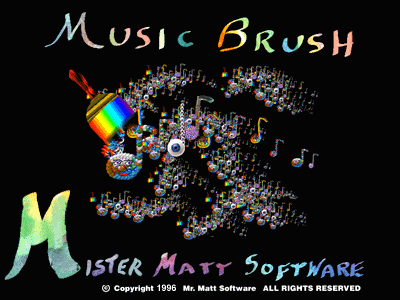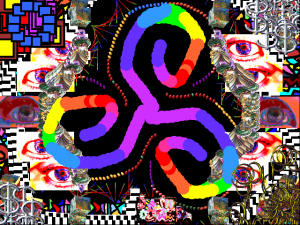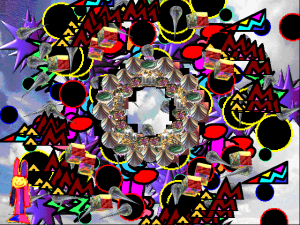Music Brush 
Painting can be a meditative experience, like in the shareware art program Music Brush. Child-friendly art software was hardly rare in the 90s, and Music Brush stands apart by focusing on the process – painting, motion, the rhythm of your brush – instead of the end result. Music Brush is all about how music interacts with that performance side of art, either in the form of an animation you can watch or as a way to collect your thoughts.
In Music Brush, you create art using pre-made stamps. Not all of the game’s stamp graphics seem useful at first. The rainbow circles and other geometric shapes (squares, stones, lines) fit well for painting, though the game also includes increasingly weirder, impractical choices, like a drawing of a fish, multiple types of eyeballs, and a truck covered in graffiti. But you aren’t meant to draw anything specific with these. The program acts more like a Spirograph; by default, it applies symmetry to your painting, and your brushes twirl and change color when you move the mouse. (Music Brush has many, many ways to customize its behavior, as outlined in an extremely thorough help file.) After a while, the fish drawings and trucks don’t look like anything in particular. Whatever you paint with, it turns abstract through repetition and gives only an impression of color, texture, weight, shape, and motion.
Music Brush accompanies your art with MIDI music, either from a built-in melody or a MIDI file of your choice. (Though the program crashed when I tried to import an Evanescence MIDI.) When you leave a stamp, the next note in the song plays. Once you’ve finished painting, however you define that, you can play back your art creation as a performance synced to the music.
Watching your painting come to life adds sort of an arc to the kaleidoscopic mess you made and a visual motif to the music you picked. Sometimes songs and stamps pair well enough together that you’d want to share it: the first time you open Music Brush, a sequence plays with a bunch of scaly eyeballs floating around to jazz music, and the two parts complement and enhance each other so well that they couldn’t live on their own.
Despite its potential for animated art like that, I got the most out of Music Brush by keeping it to myself.
Think about one of those pendulum desk toys that draws spirals in the sand. They don’t produce anything unique, but we don’t play with them with intending to make art. They’re a lightly creative play activity to direct your focus to, like making ripples in the water with your finger. Music Brush is the same way. It creates a space to play around with art, movement, and music. The option to use your creations as screensavers embodies those idle, toy-like joys. And depending on how you approach the program, it can be lively or reflective.
Developer Matt Rossoff must have created Music Brush with his family in mind. The fingerprints of a small, homegrown production are all over it, from the occasional typo to an apologetic dialogue box telling you how to disable a sound effect that uses the word “crapper” in case you find it rude. As a reminder to register the program, a recording of Rossoff’s child pleads that “Me and my daddy did a lot of work on this.” So it fits that tone to have a good time doodling on a brightly colored background with a fun MIDI playing.
But Music Brush also has an underlying eerieness. It comes through in the stranger stamps – the unusual shells and stones taken from photographs and especially all the eyeballs – and in the moody soundtrack included with the software, like the piano-and-drum loop that plays at the start of the program and the aptly named “Sad.” Music Brush has room to be evocative and, if you use the default black background, maybe a bit scary.
The right background and music set a mood where you can drift in your thoughts as you paint. I re-encountered Music Brush at an emotionally uncertain time in my life, and as silly as it sounds, I needed its canvas at that moment. Painting symmetrical stamp art across a black backdrop to the melody of “Sad” was lyrical and poignant, even finding the melancholy in light-hearted stamps like the bunny creatures that Rossoff’s kid probably doodled.
Music Brush is an art toy as much as, perhaps unintentionally, an expressionistic canvas. It can’t help but mirror the feelings you bring to it. Though that still doesn’t explain the eyeballs everywhere.
Trivia!
If you play with Music Brush, keep in mind that the now-defunct Mister Matt Software website asks you to “use the creative power of Music Brush for good and not evil.” Mister Matt Software also published Doodleworks, an art toy with many of the same symmetry features as Music Brush and ran in web browsers with Shockwave.
Download
In the interest of preservation, I have uploaded the shareware version of Music Brush 2.03 to the Internet Archive. To get a registration code for the full version, add 999762854389 to the program’s serial number.
Video
(For reference, the piano MIDI starting at 0:59 in the video is the “Sad” music mentioned earlier.)




Hi! Cool and trippy program! Unfortunately the serial number you included doesn’t work :(, or I’m just not inputting it correctly
Hi Barry! The registration code in the article (999762854389) doesn’t work by itself. To get the registration code, you have to add that to the randomly generated serial number that Music Brush gives you. Hope that clarifies things!
I tried downloading the .exe as a zip file in the link you mentioned, but when i try to open it, i get a popup saying “This app can’t run on your PC. To find a version for your PC, check with the software publisher.” Is it simply too old to run properly? I really want to be able to run this, I loved playing it all the time when I was a kid. D: